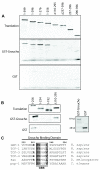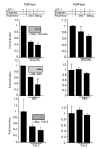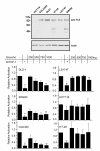Groucho binds two conserved regions of LEF-1 for HDAC-dependent repression
- PMID: 19460168
- PMCID: PMC2701438
- DOI: 10.1186/1471-2407-9-159
Groucho binds two conserved regions of LEF-1 for HDAC-dependent repression
Abstract
Background: Drosophila Groucho and its human Transducin-like-Enhancer of Split orthologs (TLEs) function as transcription co-repressors within the context of Wnt signaling, a pathway with strong links to cancer. The current model for how Groucho/TLE's modify Wnt signaling is by direct competition with beta-catenin for LEF/TCF binding. The molecular events involved in this competitive interaction are not defined and the actions of Groucho/TLEs within the context of Wnt-linked cancer are unknown.
Methods: We used in vitro protein interaction assays with the LEF/TCF family member LEF-1, and in vivo assays with Wnt reporter plasmids to define Groucho/TLE interaction and repressor function.
Results: Mapping studies reveal that Groucho/TLE binds two regions in LEF-1. The primary site of recognition is a 20 amino acid region in the Context Dependent Regulatory domain. An auxiliary site is in the High Mobility Group DNA binding domain. Mutation of an eight amino acid sequence within the primary region (RFSHHMIP) results in a loss of Groucho action in a transient reporter assay. Drosophila Groucho, human TLE-1, and a truncated human TLE isoform Amino-enhancer-of-split (AES), work equivalently to repress LEF-1*beta-catenin transcription in transient reporter assays, and these actions are sensitive to the HDAC inhibitor Trichostatin A. A survey of Groucho/TLE action in a panel of six colon cancer cell lines with elevated beta-catenin shows that Groucho is not able to repress transcription in a subset of these cell lines.
Conclusion: Our data shows that Groucho/TLE repression requires two sites of interaction in LEF-1 and that a central, conserved amino acid sequence within the primary region (F S/T/P/xx y I/L/V) is critical. Our data also reveals that AES opposes LEF-1 transcription activation and that both Groucho and AES repression require histone deacetylase activity suggesting multiple steps in Groucho competition with beta-catenin. The variable ability of Groucho/TLE to oppose Wnt signaling in colon cancer cells suggests there may be defects in one or more of these steps.
Figures






Similar articles
-
All Tcf HMG box transcription factors interact with Groucho-related co-repressors.Nucleic Acids Res. 2001 Apr 1;29(7):1410-9. doi: 10.1093/nar/29.7.1410. Nucleic Acids Res. 2001. PMID: 11266540 Free PMC article.
-
Wnt-Dependent Inactivation of the Groucho/TLE Co-repressor by the HECT E3 Ubiquitin Ligase Hyd/UBR5.Mol Cell. 2017 Jul 20;67(2):181-193.e5. doi: 10.1016/j.molcel.2017.06.009. Epub 2017 Jul 6. Mol Cell. 2017. PMID: 28689657 Free PMC article.
-
Beta-catenin directly displaces Groucho/TLE repressors from Tcf/Lef in Wnt-mediated transcription activation.Nat Struct Mol Biol. 2005 Apr;12(4):364-71. doi: 10.1038/nsmb912. Epub 2005 Mar 13. Nat Struct Mol Biol. 2005. PMID: 15768032
-
Groucho/TLE family proteins and transcriptional repression.Gene. 2000 May 16;249(1-2):1-16. doi: 10.1016/s0378-1119(00)00161-x. Gene. 2000. PMID: 10831834 Review.
-
The Groucho/Transducin-like enhancer of split protein family in animal development.IUBMB Life. 2015 Jul;67(7):472-81. doi: 10.1002/iub.1395. Epub 2015 Jul 14. IUBMB Life. 2015. PMID: 26172616 Free PMC article. Review.
Cited by
-
TCF/LEF Transcription Factors: An Update from the Internet Resources.Cancers (Basel). 2016 Jul 20;8(7):70. doi: 10.3390/cancers8070070. Cancers (Basel). 2016. PMID: 27447672 Free PMC article. Review.
-
Tle corepressors are differentially partitioned to instruct CD8+ T cell lineage choice and identity.J Exp Med. 2018 Aug 6;215(8):2211-2226. doi: 10.1084/jem.20171514. Epub 2018 Jul 25. J Exp Med. 2018. PMID: 30045946 Free PMC article.
-
WNT/β-Catenin Pathway and Epigenetic Mechanisms Regulate the Pitt-Hopkins Syndrome and Schizophrenia Risk Gene TCF4.Mol Neuropsychiatry. 2017 Jul;3(1):53-71. doi: 10.1159/000475666. Epub 2017 Jul 14. Mol Neuropsychiatry. 2017. PMID: 28879201 Free PMC article.
-
Gfi1b regulates the level of Wnt/β-catenin signaling in hematopoietic stem cells and megakaryocytes.Nat Commun. 2019 Mar 20;10(1):1270. doi: 10.1038/s41467-019-09273-z. Nat Commun. 2019. PMID: 30894540 Free PMC article.
-
A novel role for the tumour suppressor Nitrilase1 modulating the Wnt/β-catenin signalling pathway.Cell Discov. 2016 Jan 5;2:15039. doi: 10.1038/celldisc.2015.39. eCollection 2016. Cell Discov. 2016. PMID: 27462437 Free PMC article.
References
MeSH terms
Substances
Grants and funding
LinkOut - more resources
Full Text Sources
Molecular Biology Databases
Miscellaneous

